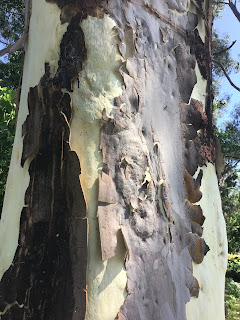They are commonly called gum trees but the botanical term eucalypt means well (eu) covered (calyptos)
They are the dominant tree type growing all over the country and are evergreens only dropping some of their leaves when under stress.The growing season for most eucalyptus is summer. When the trees grow, they put on new sap wood on the outside and expand. As a result most smooth bark eucalypts shed a lot of their bark in the summer months.
This bark shedding is called “decorticating” and is a normal thing to see, especially with smooth barked gum trees. In smooth bark types, the bark comes off in flakes curls or long strips. In rough bark eucalyptus, the bark doesn’t fall off as easily, but accumulates in entwined, stringy masses of the tree.As the bark dries and peels, it often forms colourful patches and interesting patterns on the trunk of the tree. Some trees have striking patterns of stripes and flakes, and the peeling bark may expose bright yellow or orange colours of the new bark forming underneath.
Shedding eucalyptus tree bark may help keep the tree healthy. As the tree sheds its bark, it also sheds any mosses, lichens, fungi and parasites that may live on the bark. Some peeling bark can perform photosynthesis, contributing to the rapid growth and overall health of the tree.
Unfortunately the mass of fallen bark on forest floors contributes to the potential bushfire fuel during the season.























1 comment:
I LOVE trees! This is my favorite tree in the entire world. My second fav was in Trent but old age took it out.
Post a Comment